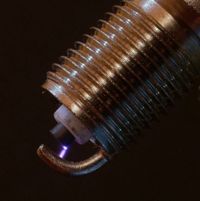
Photo from wikipedia
Purpose This study aims to achieve the fabrication of three-dimensional core-shell filament-based lattice structures by means of robocasting combined with co-extrusion. For core and shell materials, colloidal gels composed of… Click to show full abstract
Purpose This study aims to achieve the fabrication of three-dimensional core-shell filament-based lattice structures by means of robocasting combined with co-extrusion. For core and shell materials, colloidal gels composed of submicron carbon and alumina powders were developed, respectively. Simultaneously, the co-extrusion process was also studied by numerical simulation to investigate the feed pressure-dependent wall thickness. Design/methodology/approach Significant differences in the rheological behavior of the carbon and alumina gels were observed because of differences of the particle morphology and surface chemistry of the carbon and alumina powders. Precise control over the cross-sectional diameter of the core and shell green state elements was achieved by alteration of the feed pressures used during co-extrusion. Findings After subsequent thermal treatment in an oxidizing atmosphere (e.g. air), in which the carbon core was oxidized and burned out, lattice structures formed of hollow filaments of predetermined wall thickness were manufactured; additionally, C-Al2O3 core-shell filament lattice structures could be derived after firing in an argon atmosphere. Originality/value Green lattice truss structures with carbon core and alumina shell filaments were successfully manufactured by robotically controlled co-extrusion. As feedstocks carbon and alumina gels with significantly different rheological properties were prepared. During co-extrusion, the core paste exhibited a much higher viscosity than the shell paste, which benefited the co-extrusion process. Simultaneously, the core and shell diameters were exactly controlled by core and shell feed pressures and studied by numerical simulation. The experimentally and numerically derived filament wall thickness showed qualitative agreement with each other; with decreasing core pressure during co-extrusion, the wall thickness increased.
Journal Title: Rapid Prototyping Journal
Year Published: 2017
Link to full text (if available)
Share on Social Media: Sign Up to like & get
recommendations!